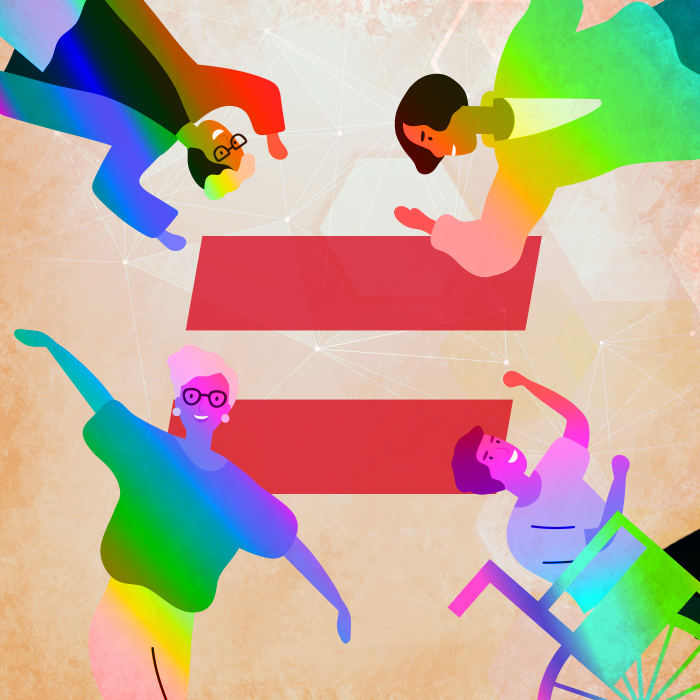SAFE interview: LGBTQIA+ people with disabilities
Written by SAFE
During Pride Month, SAFE’s Disability Services team visited with two people who identify as LGBTQIA+ and also have a disability. LGBTQIA+ people are at higher risk of experiencing violence, as are people with disabilities. Ahead of the Austin PRIDE Festival, we’re taking an opportunity to reflect on the work that still needs to be done to create truly inclusive and accepting communities and services for LGBTQIA+ people who have disabilities.
Watch Nathan’s interview and read Lauren’s responses below to learn more about how to create accessible and accepting services and communities for LGBTQIA+ people with disabilities. And be sure to scroll to the bottom for more info about the increased risk of violence faced by LGBTQIA+ people with disabilities.
Talking with Nathan
Nathan is a gay survivor with a disability who uses the pronouns he/him and identifies as a male.
Meet Lauren Gerken
Lauren is a lesbian who uses the pronouns she/her and identifies as female. She recently took the time to answer the following questions.
How do you describe your disability?
My disability is wobble-based comedic relief. Okay, technically I have cerebral palsy, but just like “lesbian” looks different on everyone, so does CP. I wobble a little when I move and I have a different speech pattern, but that’s about it.
As a lesbian with cerebral palsy, what makes you feel comfortable/safe in a community space or meeting or organization?
As a lesbian with cerebral palsy, I’m pretty confident in my own skin. That being said, little things have a big impact on how comfortable or safe I feel. I’m a modest dresser with my own style, and I carry myself very differently if I’m dressed the way I want. And being around people who don’t find it strange that I need a little help carrying my drink from place to place. As a whole, I find Austinites to be extremely supportive when I ask for help.
What do you think is the biggest barrier in getting help for LGBTQIA+ abuse survivors with disabilities?
There are a couple misconceptions that keep LGBTQIA+ abuse survivors with disabilities from speaking out, in addition to the question any survivor asks: “Will I be believed?” The first misconception is that abuse makes someone gay, or that a negative experience with one gender makes someone more attracted to the other. There is also the question of competency. If a person with a disability is abused, especially by someone without a disability, society tends to question if that person even understands abuse to begin with. Lastly, it’s yet another red letter. A gay, disabled, survivor. Unfortunately there is pity associated with each label, rather than empowerment.
Do you know where you can find help in your community if you or someone you know is abused or assaulted?
I know exactly who within my circle I can trust with information about abuse, should it happen to me. I’m also familiar with organizations through my work with advocacy groups. But because it is still a taboo subject, I don’t think it is well advertised/communicated.
What do you want people to know about LGBTQIA+ people with disabilities who have experienced abuse or assault?
It’s not the person’s fault. They didn’t ask for it by being gay or disabled. Needing help with a daily task like getting dressed or undressed is never a sexual invitation. And the individuals who experience abuse or assault deserve the community’s attention and support as much as everyone else.
What else do you want people to know about you?
I don’t think ally-ship stops between gays and straights. If you know me and need someone to talk to about a difficult experience, I’m a safe place for you.
More about the impact of violence and abuse on LGBTQIA+ people with disabilities
People who identify as LGBTQIA+ and also have a disability are often left out of conversations about abuse, despite their greater risk for violence and discrimination.
LGTBQIA+ survivors with disabilities can encounter a gap in services for violence intervention and healing, including advocates and therapists who will not work with survivors with intellectual and developmental disabilities (IDD), crisis center staff without adequate training on providing services for survivors with disabilities, and discrimination within criminal justice systems that leave survivors without justice.
Research shows that the rate of disability is higher among LGBTQIA+ adults compared to adults who do not identify as LGBTQIA+, but victim services for LGBTQIA+ people and even PRIDE celebrations may not consider how to include LGBTQIA+ people with disabilities. When LGBTQIA+ people with disabilities are not considered, they may not be able to receive the healing services they need or even to participate in PRIDE celebrations.
References
Fredriksen-Goldsen KI, Kim HJ, Barkan SE. (2012). Disability among lesbian, gay, and bisexual adults: Disparities in prevalence and risk. Am J Public Health: 102, e16-e21. Retrieved from https://www.ncbi.nlm.nih.gov/pmc/articles/PMC3490559/
Violence Against People with Disabilities Occurs at Alarming Rates. (n.d.). Retrieved from https://www.endabusepwd.org/problem/alarming-rates/
Human Rights Campaign. (n.d.). Hate Crimes and Violence Against LGBTQ People. Retrieved from https://www.hrc.org/resources/hate-crimes-and-violence-against-lgbt-people
This project was supported by Grant No. 2017-UD-AX-0008 awarded by the Office on Violence Against Women, U.S. Department of Justice. The opinions, findings, conclusions, and recommendations expressed in this publication/program/exhibition are those of the author(s) and do not necessarily reflect the views of the Department of Justice, Office on Violence Against Women.